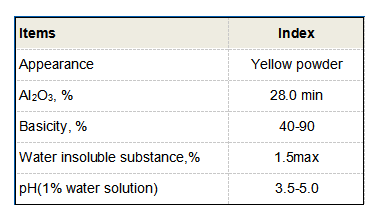Analysis and Applications of Polyaluminum Chloride Solutions in Water Treatment Processes
Understanding Polyaluminum Chloride Solution Properties, Applications, and Benefits
Polyaluminum chloride (PAC) is a widely utilized water treatment chemical known for its effective coagulation and flocculation properties. As a type of inorganic polymer coagulant, PAC is primarily used in the purification processes of drinking water and wastewater treatment facilities. In this article, we’ll explore the characteristics, various applications, and advantages of polyaluminum chloride solution, shedding light on its significance in environmental and industrial operations.
Properties of Polyaluminum Chloride Solution
Polyaluminum chloride is produced by the reaction of aluminum salts, typically aluminum hydroxide or aluminum oxide, with hydrochloric acid. The resulting compound is a specialized coagulant with a complex polymeric structure. When dissolved in water, PAC forms a solution that contains a mixture of aluminum ions and hydroxyl ions, which are essential for coagulation.
One of the most notable properties of PAC is its high charge density compared to traditional coagulants like aluminum sulfate. This higher charge density enables PAC to destabilize colloidal particles in water more effectively, leading to the formation of larger flocs that can be easily removed through sedimentation or filtration. Additionally, PAC has a lower pH requirement, which allows it to perform well across a wider range of water qualities, including those with lower alkalinity.
Applications of Polyaluminum Chloride Solution
The applications of polyaluminum chloride solution are extensive, spanning various industries
. Here are some of the primary uses1. Drinking Water Treatment PAC is commonly used in water treatment facilities to remove turbidity, color, and organic matter from water sources. Its effectiveness in coagulating fine particles makes it ideal for producing safe and clean drinking water.
2. Wastewater Treatment In municipal and industrial wastewater treatment plants, PAC helps remove suspended solids, heavy metals, and other contaminants. By enhancing the treatment process, it contributes to meeting regulatory standards for effluent quality.
3. Paper and Pulp Industry PAC is utilized in the paper manufacturing process, where it acts as a coagulant to aid in pulp preparation and improve the retention of fiber and fillers, enhancing the quality of the final product.
polyaluminum chloride solution

4. Textile Industry In textile processing, polyaluminum chloride is used for dyeing and finishing applications. It helps in fixing dyes and can also aid in the removal of excess dyes from effluent streams.
5. Food Industry Certain formulations of PAC are used in the food processing industry, particularly in the production of certain types of beverages and edible oils, where clarity and purity are essential.
Benefits of Using Polyaluminum Chloride Solution
The adoption of PAC in water treatment and other industrial processes offers several advantages
- Enhanced Performance PAC can achieve higher rates of coagulation and flocculation than traditional coagulants, reducing processing time and improving overall treatment efficiency.
- Reduced Sludge Production The use of PAC often results in lower sludge volumes compared to other coagulants, simplifying sludge handling and disposal processes.
- Lower Chemical Dosage Requirement Due to its higher efficiency, PAC typically requires lower dosages than alternatives, which can lead to cost savings and reduced environmental impact.
- Improved Water Quality The use of PAC leads to superior water quality, with significantly decreased turbidity and improved clarity, making it particularly valuable in drinking water applications.
Conclusion
Polyaluminum chloride solution stands out as a critical chemical in the field of water treatment and various industrial processes. Its unique properties, broad range of applications, and numerous benefits make it an essential component for improving water quality and process efficiency. As environmental regulations continue to become more stringent, the demand for effective coagulants like PAC will likely increase, highlighting the importance of innovation and research in water treatment solutions for sustainable development.
-
Water Treatment with Flocculant Water TreatmentNewsJun.12,2025
-
Polymaleic AnhydrideNewsJun.12,2025
-
Polyaspartic AcidNewsJun.12,2025
-
Enhance Industrial Processes with IsothiazolinonesNewsJun.12,2025
-
Enhance Industrial Processes with PBTCA SolutionsNewsJun.12,2025
-
Dodecyldimethylbenzylammonium Chloride SolutionsNewsJun.12,2025





